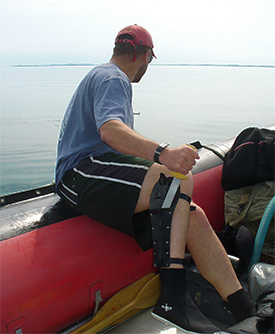
The Lake Ontario Maritime Cultural
Landscape Project
23 June 2008
By Ben Ford
What is the difference between archaeologists and treasure hunters?
This question has been a hot topic in underwater archaeology during recent years, especially with the blurring of the lines between science and industry and archaeology and marine salvage. However, until this past week I had largely stayed out of the fray, partially out of the naïve assumption that in most cases any right-minded individual could distinguish scholarly archaeological research from goodie-grabbing treasure hunting. I was wrong.

Chris prepares to go over the side after a treasure hunter or maybe a trout.
One of this year’s survey areas is immediately adjacent to a locally well known Revolutionary War fort (this journal posting is intentionally vague in the hope of partially protecting the sites involved from increased treasure hunting). The bay adjacent to this fort has been frequented by SCUBA-diving treasure hunters since the 1960s and thousands of artifacts have been removed. Some of the artifacts are now in museums, but many more are in private collections throughout the Northeast, Mid-Atlantic, and Ontario. Most of the treasure hunters who have removed artifacts from the bay are weekend-warriors who spend only a few days a year searching the bay with metal detectors. However, by returning year after year, some of them seem to have amassed substantial collections. The loss of the information contained in these artifacts is a tragedy, but it is particularly pertinent to the Lake Ontario Maritime Cultural Landscape Project because the fort, bay, and surrounding exposed and inundated lands appear to be a prime example of a maritime cultural landscape with clear evidence of individuals moving back and forth across the waterline. Hopefully, the sites will remain well enough preserved that we will be able to study them in the near future.
What makes this bay even more interesting is that it is privately owned; not only the shore of the bay, but the submerged portion of the bay as well. This is an unusual situation. In most cases, submerged lands are administered by the state. However, due to the continuation of property rights from an early nineteenth-century deed, these lands are privately owned. As a result, any disturbance of the sediments in the bay without the owner’s permission can be considered trespassing.
Unfortunately, the fact that the bay is private property did not stop two well-equipped treasure hunters from infesting the area this past week. I became tangentially involved through an association with the property owner (he also owns a substantial portion of our survey area and I approached him several months ago to gain access) and concerned members of the community. Besides offering opinions, my only actual involvement in the whole affair was, at the request of the property owner, to inspect the bottom of the bay for evidence of excavation.
The treasure hunters have now left the area and the bay does not appear to have been substantially disturbed, but it is unclear how many, if any, artifacts were removed. Looking back on the fiasco, I found two aspects incredibly interesting. First, that the treasure hunters believed that they were totally within their rights to remove artifacts from the bottom even after the property owner had directly expressed his concerns to them and they were visited by the police and coast guard. Even as a permitted archaeologist, I think that a visit from either of those groups would be a bit daunting. It should also be noted that it is illegal to remove artifacts from submerged lands claimed by the state of New York without a permit. These treasure hunters were in the wrong regardless of the owner. Secondly, I was absolutely floored by the belief of the treasure hunters and some members of the law enforcement agencies that the property owner was being discriminatory by letting archaeologists (my crew) work on one portion of his property while barring the treasure hunters from another. In their minds both activities were so similar as to be indistinguishable. Beyond the obvious difference that our project does not collect or disturb artifacts or features, there is the more important issue of intent. This brings us back to the initial question: What is the difference between archaeologists and treasure hunters? There are many answers to this question, but mine is: Archaeologists carefully and systematically recover information about the past so that the information can be interpreted and presented to the public in an attempt to benefit all of us. Treasure hunters seek and remove artifacts for the small pleasure of owning a piece of the past, but rob themselves and the rest of us of the opportunity to fully understand the artifact and its user by failing to record any but the most basic provenience. Archaeologists should be working for the benefit of all, while treasure hunters are generally driven by the selfish desire to posses.
Please feel free to contact Ben at ben.ford@iup.edu with any comments, questions, or suggestions during the weeks to come.
Return to Project Journal home page.

